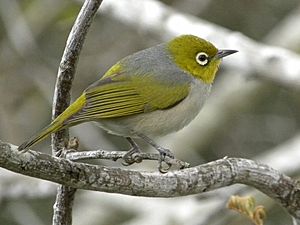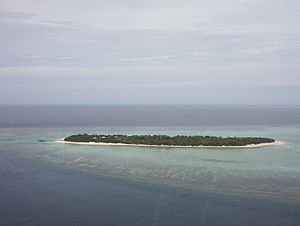Capricorn silvereye facts for kids
Quick facts for kids Capricorn silvereye |
|
|---|---|
 |
|
| Scientific classification |
|
| Kingdom: | Animalia |
| Phylum: | Chordata |
| Class: | Aves |
| Order: | Passeriformes |
| Family: | Zosteropidae |
| Genus: | Zosterops |
| Species: | |
| Subspecies: |
Z. l. chlorocephalus
|
| Trinomial name | |
| Zosterops lateralis chlorocephalus Campbell & White, 1910
|
|
| Synonyms | |
|
|
The Capricorn silvereye (Zosterops lateralis chlorocephalus) is a small, greenish bird. It's also known as the Capricorn white-eye or green-headed white-eye. This bird belongs to the Zosteropidae family, often called the white-eye family. It's a special type of silvereye that lives on islands near the coast of Queensland in north-eastern Australia. Some people even think it's a completely separate species!
Contents
What Does the Capricorn Silvereye Look Like?
The Capricorn silvereye is the only bird found only on the Great Barrier Reef. It was first described by two scientists, Archibald Campbell and Samuel White, in 1910. They studied birds collected during an expedition to the Capricorn Group of islands.
These birds have a clear ring of silvery-white feathers around their eyes. Below this, there's a black line. Their head, back, and upper wing feathers are a bright olive-green. Their lower back is grey. Their wings and tail are dark brown, with green edges on the feathers. The chin, throat, and under-tail feathers are yellowish-green. The rest of their belly is grayish-blue, becoming grayish-white on the lower belly. Their bill is dark brown, lighter at the base of the lower part. Their legs are dark grey.
Male and female Capricorn silvereyes look exactly the same. These birds are larger than the silvereyes found on the nearby mainland. Scientists have studied them to understand why island birds often grow bigger.
Where Do Capricorn Silvereyes Live?
The Capricorn silvereye lives only on the wooded coral islands of the Capricorn and Bunker Group. These islands are at the southern end of the Great Barrier Reef in Queensland. It's the only passerine (a type of perching bird) that regularly nests on Heron Island, which is about 16 hectares in size.
Scientists from the University of Queensland have studied these birds on Heron Island for a long time. They have watched the bird population there since 1965.
What is Their Habitat Like?
These birds live in the typical island forests of the region. They prefer Pisonia grandis forests, where trees can grow up to 15 meters tall. They also live in areas with Casuarina equisetifolia, Silky Celtis, Sweet Sandpaper Fig, and Octopus Bush trees and shrubs. You can also find them near human buildings, like the Heron Island resort.
How Do Capricorn Silvereyes Behave?
Breeding Habits
Studies on Heron Island show that Capricorn silvereyes choose one partner and stay with them for life. Both the male and female birds defend their nesting area during the breeding season.
Their breeding season starts in winter and spring, from August to November. The first eggs are usually laid in September or October. The chicks hatch when the early wet season rains bring out more insects for them to eat.
When the nesting season begins, males sing from high places to mark their territory. The nesting area is usually just the tree where the nest is built and the space right around it.
Nests are built in thick leaves, often in a fork of a Pisonia tree branch. Both parents build the cup-shaped nest using dry grasses, other plant materials, spiderwebs, and even human items like toilet paper or fishing line. Building a nest can take over a week.
A female usually lays three pale blue eggs. The parents take turns sitting on the eggs for 12 to 14 days until they hatch. The baby birds are born helpless and stay in the nest. Both parents feed them. The chicks leave the nest when they are 12 to 14 days old. Their parents continue to feed them for about two more weeks. Some pairs will have a second or even third set of chicks, extending the breeding season into January.
Feeding Habits
Silvereyes often look for food in small groups, or sometimes alone when they are feeding their young. They eat many different kinds of food, including insects, small invertebrates, fruit, and nectar. The sweet sandpaper fig is a very important food source for them on Heron Island.
Vocalisation (Songs and Calls)
The song of the Capricorn silvereye is a warble, which means it's a series of sweet, flowing notes. Their songs are complex and well-organized. Each bird learns its song repertoire by its first breeding season.
They sing most often during the breeding season. All the males in a territory sing together in a "dawn chorus" for about 20 minutes at sunrise. You might also hear them singing occasionally throughout the day. During the dawn chorus, they sing about six or seven songs per minute. Each song lasts about five seconds and has around 16 different notes.
Population and Threats
A study on Heron Island between 1979 and 1993 tracked the population of Capricorn silvereyes. The number of birds on the island changed between 225 and 483 individuals. Four cyclones during that time caused many birds to die.
The main reason why all the baby birds in a nest are lost is often because the nest wasn't built well and it tilts. Nests built early in the dry season can be damaged if leaves fall from the trees. Nests built later in the season are at risk from heavy rain and strong winds. Young birds that have just left the nest can be caught by eastern reef egrets in the trees. On the ground, they can be hunted by silver gulls and buff-banded rails.


